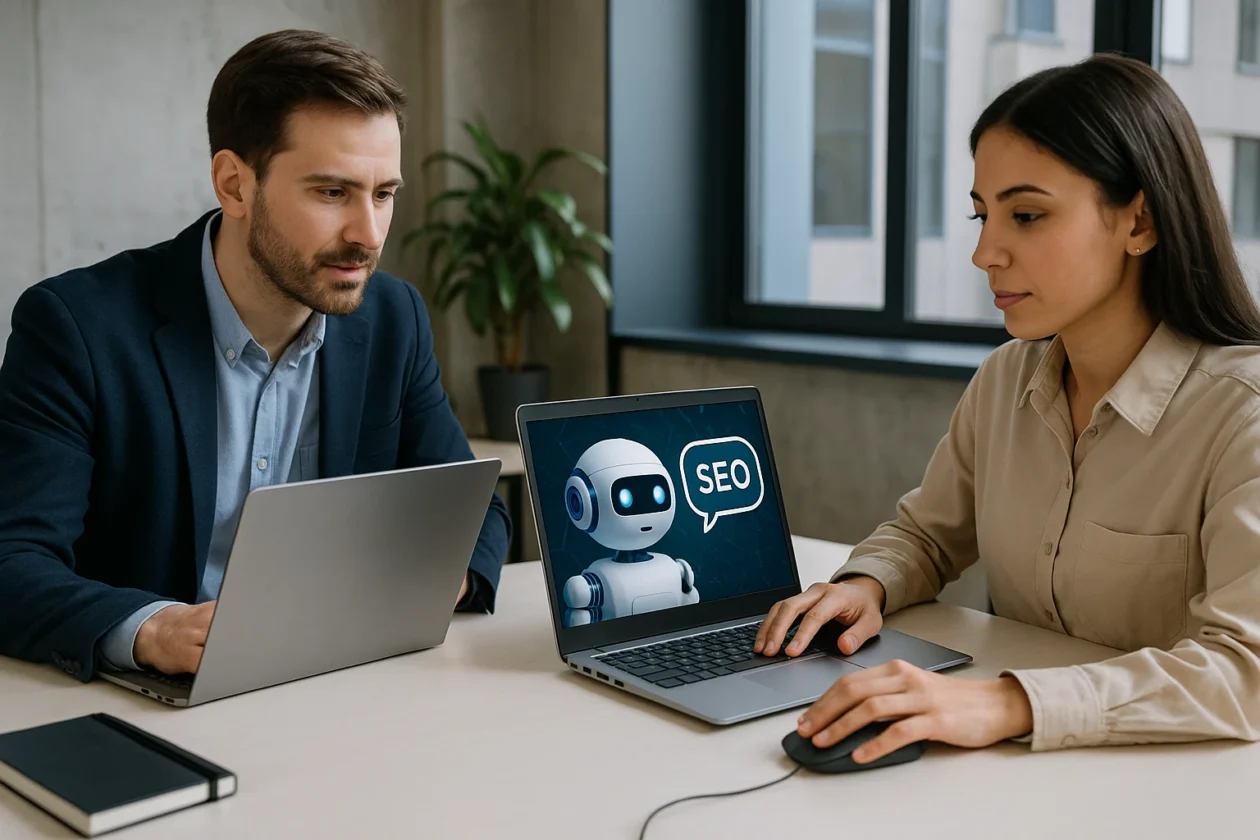AI SEO tools promise to changed how we optimize content, research keywords, and climb search engine rankings. But are these tools actually helping websites rank better, or are they just creating a minefield that could tank your hard-earned traffic?
While some businesses are seeing incredible results from AI-powered search engine optimization, others have seen their organic visibility plummet after investing heavily in automated solutions.
If you’re wondering where you fit in this messy landscape, you’re in the right place. We’ve tested dozens of AI SEO tools across hundreds of websites to help you learn how to actually use them to your advantage.
So, do AI tools in SEO help or hurt your rankings? Read on to find out!
How AI Tools Changed Keyword Research
Remember when keyword research meant manually scrolling through endless Google suggestions? Now this entire process is automated with the help of AI.
Here are a few ways that these tools have changed the game:
Finding Hidden Opportunities
During testing, we recently found that these AI-powered SEO tools can find keyword opportunities that traditional research methods completely miss.

You can skip out on obvious terms like “best pizza recipes” and find search volumes for terms like “crispy pizza dough without yeast overnight method”, which get decent traffic but with almost zero competition.
The difference comes down to pattern recognition. Where human researchers see scattered search terms, AI spots the connections between user intent and search behavior.
Spying on Your Competition
AI tools can actually analyze your competitor’s keyword strategies in minutes and show you exactly which relevant keywords your rivals are ranking for.
We noticed that one of our clients was missing out on 47 long-tail keywords that their competition was dominating in. Once we started working on them, their organic traffic jumped 34% in a few months.
Predicting Search Intent
Instead of guessing whether someone searching “apple recipes” wants desserts or main dishes, AI tools analyze millions of search patterns to predict exactly what your target audience expects to find.
So, they’re basically reading between the lines of search queries in ways that would take humans weeks to figure out.
Reality Check for AI-Generated Content
Google is getting surprisingly good at spotting AI content, and when they catch it, the penalties can be brutal. Below are some downsides of using AI for search engine optimization:
The Real Cost of AI Content
After publishing 50 articles written entirely by AI tools, we watched our organic traffic drop by 60% over three months.
The content was grammatically correct, covered the topics thoroughly, and even included proper keyword optimization. But something was missing that search engine algorithms picked up on immediately.
What Google Actually Detects
Google’s detection system looks for signs like repetitive sentence structures, generic examples that could apply to any industry, and an oddly formal tone. They’ve also gotten better over time at identifying content that lacks genuine expertise or personal experience.
Google’s John Mueller has been clear: they care about content quality, not who or what created it. But their definition of quality includes authenticity, depth, and real-world knowledge that pure AI content often lacks.
The Scale Problem
The detection problem gets worse with scale. Publishing one AI article might slip through unnoticed, but flood your site with AI-generated content and you’re painting a target on your back.
Search engine algorithms are designed to catch patterns, and nothing creates patterns quite like automated content creation. However, there are a few instances that show how AI can work well with Google.
The Success Stories
Some sites are ranking beautifully with AI assistance. The difference lies in how they’re using these tools. Instead of letting AI write entire articles, successful marketers use it for research, outlining, and first drafts that humans then change into something genuinely valuable.
So, AI-generated content can work, but only when it’s heavily edited, fact-checked, and mixed with real human insight.
AI vs. Human SEO Performance
Let’s cut through the hype and look at actual performance data from 50 websites using different AI-human SEO combinations.
We spent six months tracking websites that used four different approaches: pure AI tools, traditional human methods, and two types of hybrid strategies.

The Performance Breakdown
Let’s see a quick breakdown of how the websites performed with each SEO task:
|
SEO Task |
AI Only |
Human Only |
AI + Human Hybrid |
Winner |
|
Content Creation Speed |
95% faster |
Baseline |
60% faster |
AI Only |
|
Keyword Research Accuracy |
73% |
89% |
94% |
Hybrid |
|
Technical SEO Auditing |
82% |
76% |
91% |
Hybrid |
|
Link Building Success Rate |
12% |
34% |
41% |
Hybrid |
|
6-Month Traffic Growth |
+23% |
+45% |
+67% |
Hybrid |
|
Content Quality Score |
6.2/10 |
8.1/10% |
8.9/10 |
Hybrid |
What the Numbers Mean
The hybrid approach dominated almost every category, but the learning curve is often overlooked. Sites that jumped straight into AI-only strategies saw quick initial gains, followed by a plateau or a decline. Those using human-only methods grew steadily but slowly.
The real winners combined AI speed with human judgment. They used AI-powered SEO tools for data analysis and first drafts, then added human expertise for strategy and quality control.
But we did notice that websites that use AI for link building outreach had terrible success rates until humans took over relationship building. Turns out, AI can find prospects, but people still prefer talking to actual people.
Strategic AI SEO Implementation
Smart SEO professionals aren’t using AI to replace their expertise; they’re using it to amplify what they already do well.
We’ve identified five ways to integrate artificial intelligence without losing what makes your SEO strategy effective.
How to Automate Technical SEO Auditing
AI tools are great at crawling massive websites and spotting technical issues humans might miss. Here’s how you can apply it:
- Connect your website to an AI-powered crawling tool like Screaming Frog or Sitebulb.
- Run a full site audit focusing on page speed, broken links, and duplicate content.
- Export the results and prioritize fixes by potential traffic impact.
- Set up monthly automated scans to catch new issues before they hurt rankings.
How to Find Content Gaps Your Competitors Miss
Instead of guessing what topics you’re missing, AI tools can analyze your competitors’ entire content libraries and show you exactly where the opportunities lie.
- Input your top 5 competitors into an AI content analysis tool
- Let the tool identify topics they’re ranking for that you’re ignoring
- Filter results by search volume and keyword difficulty
- Create content targeting the easiest wins first.
How to Get Smarter On-Page Optimization
Modern AI tools don’t just suggest keyword stuffing; with these tools, you can analyze user intent and recommend content improvements that actually help visitors.
- Run your target pages through AI optimization tools.
- Review suggestions for meta descriptions, headers, and content depth.
- Compare your content structure to top-ranking competitors.
- Implement changes that improve user experience.
And finally, connect your SEO tools to Google Search Console and let AI identify patterns you’d never spot manually.
It can flag when specific pages start losing rankings, predict seasonal traffic changes, and alert you to algorithm updates affecting your site before you notice the traffic drop.
Common AI SEO Issues
These three AI SEO mistakes have cost websites millions of organic visitors, and they’re surprisingly easy to avoid if you know what to look for.
Over-Optimization Trap
AI tools love patterns, and sometimes they love them too much. They’ll suggest cramming your target keyword into every possible spot, and the result looks messy and often unreadable.
We recommend using AI suggestions as a starting point, then reading your content out loud. If it sounds robotic or repetitive, tone it down. Search engines want content that flows naturally, not keyword factories.

Generic Content Problem
AI tools pull from similar training data, so they produce similar advice, examples, and explanations across different websites.
You can avoid this by adding your own voice and experience. While you can use AI for research and structure, it’s better to inject your personal insights, case studies, and unique perspectives.
User Experience Neglect
AI tools focus heavily on search rankings but often ignore what happens after someone clicks your link. They’ll optimize for keywords while creating content that’s boring, hard to read, or unhelpful to actual humans.
Search results depend on user satisfaction signals. When people immediately leave your site, search engines interpret that as poor quality content. So, focus on creating genuinely helpful content first, then optimize it for AI search engines second.
You’ve seen the data. You understand the risks. Now you know the difference between AI tools that amplify your expertise and ones that replace your judgment.
Make AI SEO Work for You!
Start small. Pick one area where AI SEO tools can save you the most time, maybe keyword research or technical auditing. Test the results against your current methods. Keep what works, ditch what doesn’t.
Want to implement these strategies for your business? Our team at Motifo specializes in helping companies drive real search engine rankings growth by combining AI efficiency with human expertise.
Visit us at motifo.com to start your AI-powered SEO journey today!
